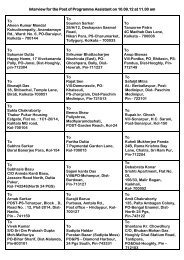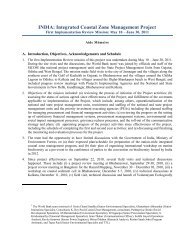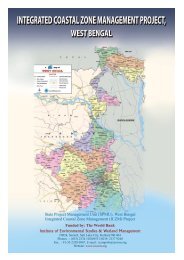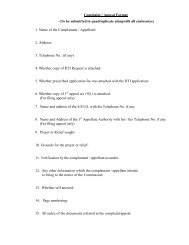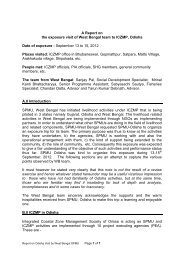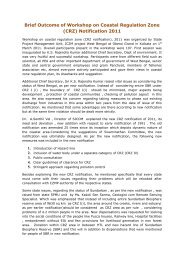BID Document for Guest House with Boundary Wall.pdf - Integrated ...
BID Document for Guest House with Boundary Wall.pdf - Integrated ...
BID Document for Guest House with Boundary Wall.pdf - Integrated ...
You also want an ePaper? Increase the reach of your titles
YUMPU automatically turns print PDFs into web optimized ePapers that Google loves.
the work is in progress, the Contractor shall provided and use warning and / or traffic signs / lights or lanterns,<br />
barricades, fencing, watchman, etc.<br />
2.1.5 Extra Depth and Clearance:<br />
At points where the contour of the earth may require extra depth according to customary good pipeline<br />
practice, or where a deep trench is required at the approaches to crossings of roadways, sewer line, Contractor<br />
shall excavate such additional depth as may necessary after obtaining permission from the EIC.<br />
Contractor shall excavate to additional depth as directed by the Engineer-In-Charge, where the pipeline<br />
approaches and crosses other pipelines, sewers, drain pipes, telephone conduits and other underground<br />
structures and specific low lying area so that the pipeline may be laid <strong>with</strong> at least 50 centimeters free<br />
clearance from the obstacle or as specified in the drawings, or such greater minimum distances as may be<br />
required. No pipeline shall be laid so as to be in contact <strong>with</strong> any electrical supply line, telegraph line, drain,<br />
sewer or connection work.<br />
Where the pipeline crosses areas, whose basement specifically require greater than normal depths of cover the<br />
trench shall be excavated to extra depth in accordance <strong>with</strong> the Right of Way agreement or as required.<br />
Contractor shall excavate all such additional depths to maintain the depth of earth cushion beyond 1.20 mtr as<br />
may be necessary <strong>for</strong> satisfactory completion of the work.<br />
Clearance on one side or the other of any interfering structures shall be determined on the field in accordance<br />
<strong>with</strong> the circumstances of each case <strong>with</strong> the provision that the line shall be laid as directed by the Engineer-<br />
In-Charge. Temporary under passing supports and other protective devices necessary to keep interfering<br />
structures unaffected, shall be provided by the Contractor and shall be of such design so as to ensure against<br />
their possible failure.<br />
2.1.6 Finish of Trench:<br />
The employer intends that there shall be a minimum of hand guarding of the trench bottom However, to<br />
achieve this, Contractor shall have to dig as square a bottom of the trench as possible <strong>with</strong> the equipment. This<br />
in part can be obtained by adjusting and adopting the crumbling shoe and digging teeth of the trenching<br />
machines and by use of a drag behind the trenching machines. Contractor shall do hand work in the trench if<br />
necessary to free the bottom of the trench from loose rock and hard soil and to trim protruding roots from the<br />
bottom and side walls of the trench. However, the Contractor has the liberty to adopt any procedure according<br />
to site condition <strong>with</strong> due approval of the Engineer-In-Charge. Trench compactor should be used to compact<br />
the bed.<br />
2.1.7 Padding:<br />
In all cases where rock or gravel is encountered in the bottom of trench, trench padding shall be provided to<br />
safeguard the pipe coating. The extent of trench padding (length) shall be decided by the Engineer-In-Charge.<br />
The thickness of the compacted padding shall not be less than 150 mm. In those areas that are to be padded<br />
the trench shall be at least 150 mm deeper than otherwise required, and evenly and sufficiently padded to keep<br />
the pipe, when in place at least 150 mm above the bottom of excavated trench. Padding materials shall be sand<br />
containing no gravel, rock, or lumps of hard soil.<br />
2.1.8 Protection of Trench:<br />
Contractor shall keep the trench in good conditions until the pipe is laid. All type of safety measures <strong>for</strong><br />
excavation work shall be taken and maintained as required. The Contractor shall provide, install and operate<br />
all the necessary pumping machineries, piping appliances and equipments and supply fuel, etc. to keep trench<br />
reasonably free from any water during excavation.<br />
2.1.9 Protection Of Underground Utilities:<br />
Contractor shall obtain plans and full details of all existing and planed underground services from the EIC and<br />
shall follow plans & co-ordinates closely at all time during the per<strong>for</strong>mance of work. Contractor shall be<br />
responsible <strong>for</strong> action and protection of all underground lines and structures. In special locations, the use of<br />
trenching machine / backhoe may result in damage of property and subsurface structures likely to be<br />
encountered during excavation. At such places, Contractor shall excavate the trench manually to same<br />
specifications.<br />
Where the pipeline crosses other underground utilities / structures, Contractor shall first manually excavate to<br />
a depth the utilities / structures are located.<br />
Temporary underpinning, or any other type of supports and other protective devices necessary to keep the<br />
interfering structure intact shall be provided by Contractor to ensure against their possible failure.<br />
In locations, where the pipeline has to be laid more or less parallel to an existing pipeline, cable and / or other<br />
utilities in the right of way Contractor shall per<strong>for</strong>m the work to the satisfaction of the Authority of the<br />
existing pipeline / cable / utility. In such locations Contractor shall per<strong>for</strong>m work in such way that even under<br />
86






